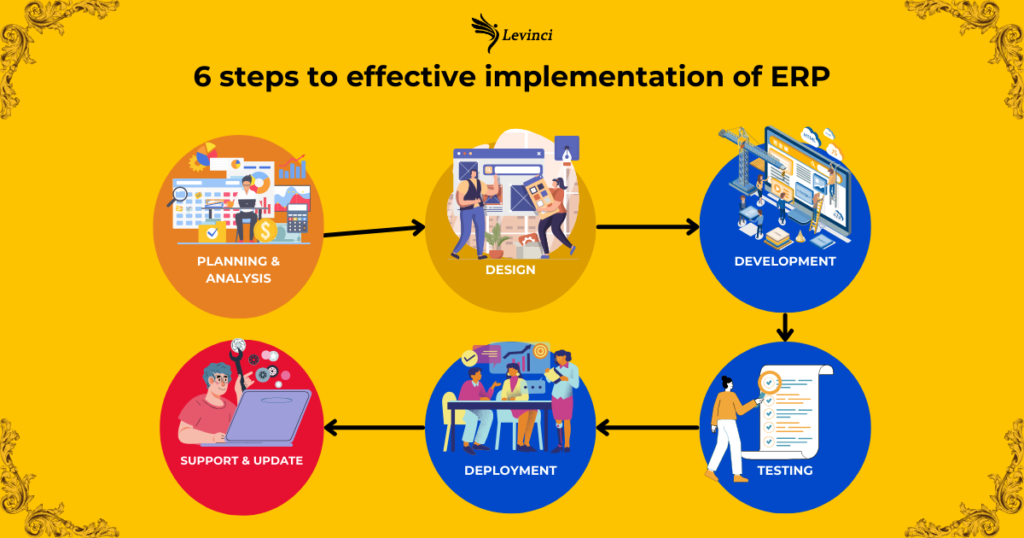Enterprise resource management (ERP) systems play an important role in optimizing operations and improving business efficiency. Successful implementation of ERP requires a methodical and scientific process, ensuring smooth coordination between departments and active participation from the board of directors. This article will give you an overview of the implementation of ERP, including key steps and important factors to keep in mind.
Definition of implementation of ERP
The implementation of an Enterprise Resource Planning (ERP) system refers to the process of installing, configuring, and deploying an ERP software solution within an organization. ERP implementation involves a series of steps aimed at integrating the ERP system into the existing business processes of the organization to streamline operations, improve efficiency, and facilitate better decision-making.
However, if a business does not have clear preparation and has problems implementing the ERP system, it will face many difficulties such as wasting money and time; data migration problems, inconsistencies, and difficulties in generating accurate reports.
6 steps to effective implementation of ERP
ERP implementation is the process of installing and configuring an ERP software system within a company. Here’s a breakdown of the typical ERP implementation process:

Step 1: Planning & Analysis
This initial phase involves defining your business needs, goals, and budget for the ERP system. In this step, you will also assess your current IT infrastructure, and analyze its existing business processes to identify inefficiencies and any potential gaps or areas for improvement. Additionally, you need to allocate resources as well as establish some key performance indicators (KPIs) to measure effectiveness.
Step 2: Design
Based on the analysis, you’ll select a specific ERP software that best suits your company’s requirements. You’ll then work with consultants and developers to customize the software to fit your specific workflows and data needs.
Step 3: Development
The development stage will be very important and difficult. However, if you do it properly and thoroughly, the ERP system will last a long time.
In this stage, the chosen ERP software is installed and configured according to the defined specifications. This may involve system development, customization, and data migration from your existing systems.
Step 4: Testing
Before deploying the ERP system in a live environment, thorough testing is conducted. This is also an important stage because it will ensure all applications and processes operate stably before the ERP system officially goes live. This includes data integrity testing, user acceptance testing, and system integration testing.
Step 5: Deployment
Once testing is completed, the ERP system is deployed in a live environment. This step includes operations such as migrating data from legacy systems, configuring user access rights, and completing system settings.
Then, you need to spend time educating and training users on how to use the new ERP system effectively.
Step 6: Support & Updates
The ERP system goes live, and the business begins using it for day-to-day operations. Businesses should regularly test and maintain, periodically upgrade software to optimize system performance, and ensure continuous improvement.
This process requires close cooperation between the organization, employees and stakeholders to ensure the ERP system operates most effectively.
Ways to minimize risks during the implementation of ERP system

Meticulous planning and preparation
To do this step well, you need to conduct comprehensive planning before starting the implementation process, define clear objectives, establish realistic timelines, and allocate resources appropriately. Additionally, you need to identify potential risks and develop contingency plans to address them proactively.
Identify precise and clear goals
To increase your company’s operational efficiency and business profits using an implemented ERP system, you need to clearly understand which goals you want to achieve and which problems need to be solved. This helps ensure the chosen system aligns with your needs and avoids scope creep later.
Select the Right ERP Solution
You need to research and compare different ERP systems based on your company size, industry, budget, and functionality requirements to choose an ERP system that aligns with the organization’s requirements, scalability, and long-term goals. Additionally, you need to consider factors such as vendor reputation, industry experience, system flexibility, and ease of customization.
Choose experienced implementation partners
Partner with experienced consultants who have a proven track record of successful ERP implementations in your industry. Their expertise can help navigate complexities and avoid common pitfalls.
Select and deploy the suitable ERP system with Levinci
A successful implementation can significantly improve your business efficiency, data management, and overall operational effectiveness. Therefore, you need to choose the right ERP system and partner with experienced consultants to significantly increase the chances of a successful implementation.
Learn more what is ERP? and why ERP is important for businesses?
Levinci is proud to be one of the most experienced units in providing and implementing ERP systems for businesses in all fields. Levinci’s custom ERP system is designed specifically to address your company’s unique workflows, processes, and data requirements. It can modify and add necessary features and applications for each business needs to improve efficiency and productivity across various departments.
Conclusion
Implementation of ERP is a complex and resource-intensive process that requires careful planning, collaboration among various stakeholders, and effective project management to ensure success. If you want to own a complete ERP system, please contact Levinci immediately!

